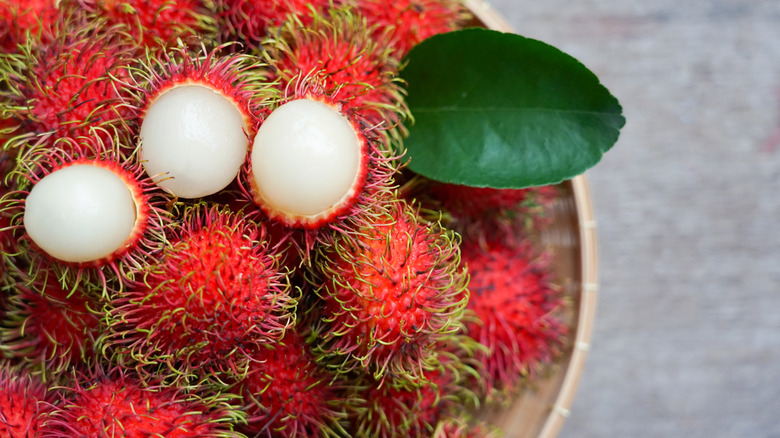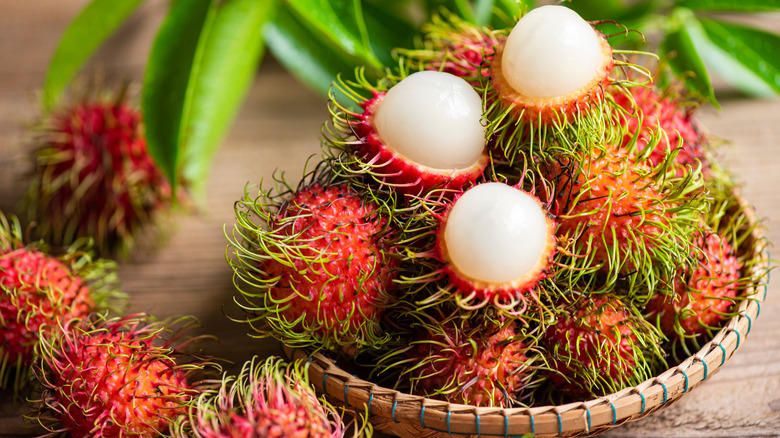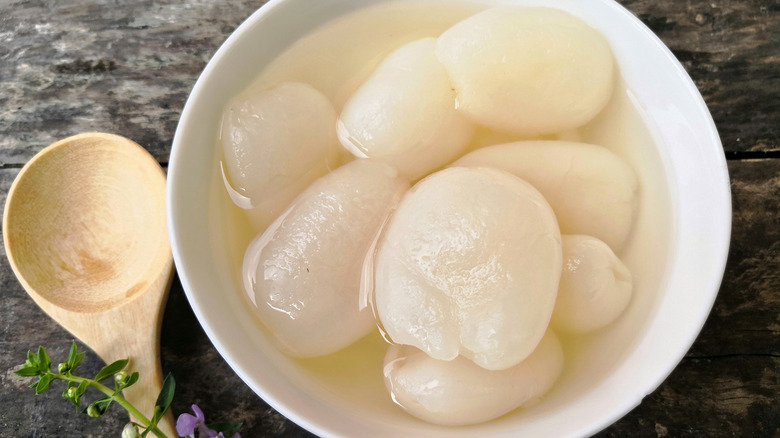How To Cut Into Rambutan And Eat The Spiky Fruit
With so many fruits in the world — roughly 2,000 types — you'll be forgiven for not knowing every single one. The fruit rambutan has been gaining attention and has been touted as a superfood or super fruit due to its nutrient content.
At first glance, the red and spiky fruit may seem difficult to eat. But like most fruits, you need to peel away the spiky exterior to get to the edible goodness. And don't worry; the spikes are soft.
To enjoy a rambutan, cut open the fruit by making a small incision into the skin. Then squeeze out the rambutan until a fruit that resembles a white grape pops out. Remove the seed inside of the rambutan by cutting into the flesh. The shell and fruit itself are soft and pliable enough to use your fingers to tear away both the skin and to remove the seed if no cutting utensil is available.
Rambutans contain numerous health benefits
Rambutan is commonly eaten throughout Asia and originated in Malaysia. In fact, the word rambutan comes from the Malaysian word "rambut," which means hair, fitting for the fruit's spikes covering its exterior. According to Science Direct, the fruit is mainly grown in Thailand, Sri Lanka, Indonesia, and the Philippines.
Now, the fruit is being grown and eaten worldwide — rambutans are grown in South America, the Caribbean, and Hawaii, to name a few places. The tropical fruit is touted not only for its sweetness but especially for its numerous health benefits. Rambutan is a good source of potassium, vitamin C, and B5; the latter helps convert food into energy. Rambutans' high fiber content can help with digestion.
If you're looking to try rambutan for the first time, fresh and canned versions can be found at most Asian grocery stores. Rambutans are usually in abundance in the winter, from December to January, but you can expect to find canned rambutans year-round.
How to use rambutans
Sure, a rambutan is tasty by itself, but you can also incorporate the fruit into nearly any dish. The fruit is mainly seen in desserts. Not sure where to start? Try making popular Southeast Asian desserts that already feature rambutans. Make a Vietnamese fruit cocktail, also known as chè thái. It's a dessert consisting of tropical fruits like rambutan, lychee, jackfruit, and jellies covered in coconut milk. Or add rambutans to halo-halo, a similar Filipino dessert. Rambutan pairs well with other tropical fruits — enjoy them in a fruit salad with mango, dragonfruit, kiwi, and cherries. Or you can blend these fruits for a tropical smoothie.
An easy way to build rambutans into your diet is by adding them to fruit smoothies alongside mango, pineapples, or fruit salads. Rambutans also go great in cocktails; make a lychee martini, but swap out lychee for the spiky fruit instead. You can make rambutan ice cream or jam if you're feeling ambitious. Rambutans can also make savory dishes, such as a coconut milk-based curry. In a pot, add chicken and cook until brown. Then, add spices such as turmeric, cumin, cayenne, and coriander. Pour in coconut milk and add vegetables like bell peppers and rambutan. Simmer until the curry thickens. Whether you like savory or sweet, rambutans are just as tasty and can be eaten by themselves.


